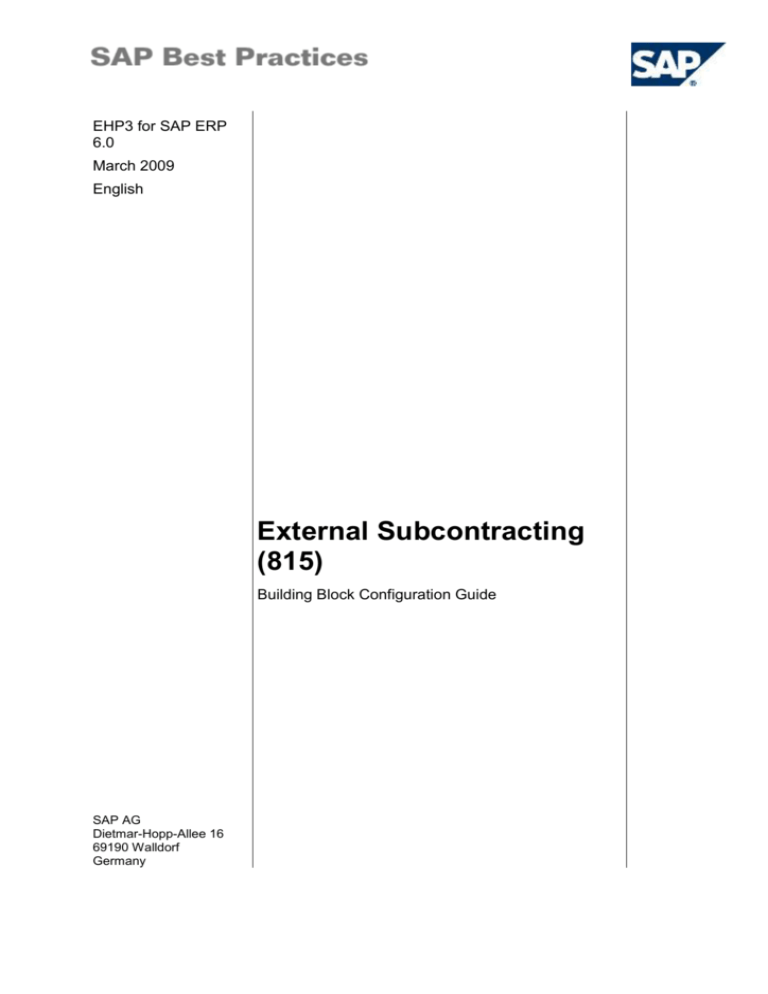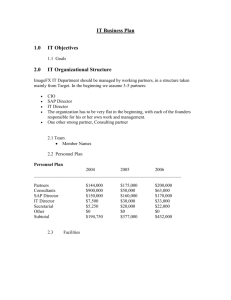
EHP3 for SAP ERP
6.0
March 2009
English
External Subcontracting
(815)
Building Block Configuration Guide
SAP AG
Dietmar-Hopp-Allee 16
69190 Walldorf
Germany
SAP Best Practices
External Subcontracting (815): Configuration Guide
Copyright
© Copyright 2009 SAP AG. All rights reserved.
No part of this publication may be reproduced or transmitted in any form or for any purpose
without the express permission of SAP AG. The information contained herein may be
changed without prior notice.
Some software products marketed by SAP AG and its distributors contain proprietary
software components of other software vendors.
Microsoft, Windows, Excel, Outlook, and PowerPoint are registered trademarks of Microsoft
Corporation.
IBM, DB2, DB2 Universal Database, OS/2, Parallel Sysplex, MVS/ESA, AIX, S/390, AS/400,
OS/390, OS/400, iSeries, pSeries, xSeries, zSeries, System i, System i5, System p, System
p5, System x, System z, System z9, z/OS, AFP, Intelligent Miner, WebSphere, Netfinity,
Tivoli, Informix, i5/OS, POWER, POWER5, POWER5+, OpenPower and PowerPC are
trademarks or registered trademarks of IBM Corporation.
Adobe, the Adobe logo, Acrobat, PostScript, and Reader are either trademarks or registered
trademarks of Adobe Systems Incorporated in the United States and/or other countries.
Oracle is a registered trademark of Oracle Corporation.
UNIX, X/Open, OSF/1, and Motif are registered trademarks of the Open Group.
Citrix, ICA, Program Neighborhood, MetaFrame, WinFrame, VideoFrame, and MultiWin are
trademarks or registered trademarks of Citrix Systems, Inc.
HTML, XML, XHTML and W3C are trademarks or registered trademarks of W3C®, World
Wide Web Consortium, Massachusetts Institute of Technology.
Java is a registered trademark of Sun Microsystems, Inc.
JavaScript is a registered trademark of Sun Microsystems, Inc., used under license for
technology invented and implemented by Netscape.
SAP, R/3, xApps, xApp, SAP NetWeaver, Duet, PartnerEdge, ByDesign, SAP Business
ByDesign, and other SAP products and services mentioned herein as well as their respective
logos are trademarks or registered trademarks of SAP AG in Germany and in several other
countries all over the world. All other product and service names mentioned are the
trademarks of their respective companies. Data contained in this document serves
informational purposes only. National product specifications may vary.
These materials are subject to change without notice. These materials are provided by SAP
AG and its affiliated companies ("SAP Group") for informational purposes only, without
representation or warranty of any kind, and SAP Group shall not be liable for errors or
omissions with respect to the materials. The only warranties for SAP Group products and
services are those that are set forth in the express warranty statements accompanying such
products and services, if any. Nothing herein should be construed as constituting an
additional warranty.
© SAP AG
Page 2 of 9
SAP Best Practices
External Subcontracting (815): Configuration Guide
Icons
Icon
Meaning
Caution
Example
Note
Recommendation
Syntax
Typographic Conventions
Type Style
Description
Example text
Words or characters that appear on the screen. These include field
names, screen titles, pushbuttons as well as menu names, paths and
options.
Cross-references to other documentation.
Example text
Emphasized words or phrases in body text, titles of graphics and tables.
EXAMPLE TEXT
Names of elements in the system. These include report names,
program names, transaction codes, table names, and individual key
words of a programming language, when surrounded by body text, for
example, SELECT and INCLUDE.
Example text
Screen output. This includes file and directory names and their paths,
messages, source code, names of variables and parameters as well as
names of installation, upgrade and database tools.
EXAMPLE TEXT
Keys on the keyboard, for example, function keys (such as F2) or the
ENTER key.
Example text
Exact user entry. These are words or characters that you enter in the
system exactly as they appear in the documentation.
<Example text>
Variable user entry. Pointed brackets indicate that you replace these
words and characters with appropriate entries.
© SAP AG
Page 3 of 9
SAP Best Practices
External Subcontracting (815): Configuration Guide
Contents
Procurement of Pipeline Materials: Configuration Guide .......................................................... 5
1.
Purpose........................................................................................................................... 5
2.
Preparation ..................................................................................................................... 5
2.1
Prerequisites ............................................................................................................ 5
2.1.1
3.
Building Blocks..................................................................................................... 5
Configuration .................................................................................................................. 5
3.1
4.
Delivery Item Category Determination ..................................................................... 5
Master Data .................................................................................................................... 5
4.1
Creating Vendor for different Account Groups ......................................................... 6
4.2
Creating Customer for Subcontracting ..................................................................... 6
4.3
Changing Vendor ..................................................................................................... 6
4.4
Creating Info Record ................................................................................................ 7
4.5
Creating QM Info Record ......................................................................................... 7
4.6
Creating and Changing BOM ................................................................................... 7
4.7
Creating and Changing Master Recipes .................................................................. 8
4.8
Defining and checking Production Versions ............................................................ 8
4.9
Changing Master Recipes ........................................................................................ 9
© SAP AG
Page 4 of 9
SAP Best Practices
External Subcontracting (815): Configuration Guide
Procurement of Pipeline Materials:
Configuration Guide
1. Purpose
This configuration guide provides the information you need to set up the configuration of this
building block manually.
2. Preparation
2.1 Prerequisites
2.1.1
Building Blocks
Before you start installing this scenario, you must install prerequisite building blocks. For more
information, see the Building Block Prerequisites Matrix for Chemicals.
3. Configuration
3.1 Delivery Item Category Determination
Use
The purpose of this activity is to maintain the item determination for the delivery type LB and
the Item category group VERP (VERB is used in material master CH-4120).
Procedure
1. Access the activity using one of the following navigation options:
IMG Menu
Logistic execution Shipping Deliveries Define Item
Category Determination in Deliveries
Transaction Code
0184
2
On the Change View “Delivery item category determination”: Overview screen copy the
entry LB/NORM to LB/VERB. The default item category for delivery LBN will be copied
automatically.
3
Choose Save.
Result
A new combination of delivery type, item category group and item category was created.
4. Master Data
The following activities describe the master data required for this Building Block. The steps do
not describe the transactions in detail but list the relevant transaction and the corresponding
master data file. For more details on using the individual transactions refer to the Online Help
in the system.
© SAP AG
Page 5 of 9
SAP Best Practices
External Subcontracting (815): Configuration Guide
4.1 Creating Vendor for different Account Groups
Use
The purpose of this activity is to create vendor for different Account Groups. A vendor is a
business partner from whom goods and services can be procured.
Procedure
1. Access the activity using one of the following navigation options:
SAP Menu
Logistics Materials Management Purchasing Master
Data Vendor Central Create
Transaction Code
XK01
2. Refer to the following file for details of the master data required:
SMB15_XK01_O010_J30_815.TXT
4.2 Creating Customer for Subcontracting
Procedure
1. Access the activity using one of the following navigation options:
SAP Menu
Logistics Sales and Distribution Master Data Business
Partner Customer Create Complete
Transaction Code
XD01
2. Refer to the following file for details of the master data required:
SMB15_SD_CUSTOMER_O034_J30_815.TXT
4.3 Changing Vendor
Use
The purpose of this activity is to change vendor for and assign a customer to it.
Procedure
1. Access the activity using one of the following navigation options:
SAP Menu
Logistics Materials Management Purchasing Master
Data Vendor Central Create
Transaction Code
XK01
2. Refer to the following file for details of the master data required:
SMB15_XK02_O002_Q13_815.TXT
© SAP AG
Page 6 of 9
SAP Best Practices
External Subcontracting (815): Configuration Guide
4.4 Creating Info Record
Use
The purpose of this activity is to create an info record. The info record establishes the link
between material and vendor, thus facilitating the process of selecting quotations. For
example, the info record shows the unit of measure used for ordering from the vendor, and
indicates vendor price changes affecting the material over a period of time.
Procedure
1. Access the activity using one of the following navigation options:
SAP Menu
Logistics Materials Management Purchasing Master
Data Info Record Create
Transaction Code
ME11
2. Refer to the following file for details of the master data required:
SMB99_ME11_O250_J01_815.TXT
4.5 Creating QM Info Record
Use
The purpose of this activity is to create a QM info record. The info record establishes the link
between material and vendor, thus facilitating the process of selecting quotations. For
example, the info record shows the unit of measure used for ordering from the vendor, and
indicates vendor price changes affecting the material over a period of time.
Procedure
1. Access the activity using one of the following navigation options:
SAP Menu
Logistics Quality Management Quality Planning
Logistics Master Data Quality Info Record: Procurement
Create
Transaction Code
QI01
2. Refer to the following file for details of the master data required:
SMB18_QI01_O002_Q41_815.TXT
4.6 Creating and Changing BOM
Use
The purpose of this activity is to create BOM headers and required items.
Procedure
1. Access the activity using one of the following navigation options:
SAP Menu
© SAP AG
Logistics Production Master Data Bills of Material
Bill of Material Material BOM Create/Change
Page 7 of 9
SAP Best Practices
Transaction Code
External Subcontracting (815): Configuration Guide
CS01/CS02
2. Refer to the following file for details of the master data required:
SMB10_BOM_O998_P09_815.TXT
Result
BOMs were created.
4.7 Creating and Changing Master Recipes
Use
The purpose of this activity is to create master recipes.
Procedure
1. Access the activity using one of the following navigation options:
SAP Menu
Logistics Production - Process Master Data Master
Recipes Recipe and Material List Create
Transaction Code
C201
2. Refer to the following file for details of the master data required:
SMB99_MASTER_RECIPE_O201_J01_815_01.TXT
Result
Master recipe headers were created.
4.8 Defining and checking Production Versions
Use
The purpose of this activity is to define and check production versions.
Procedure
1. Access the activity using one of the following navigation options:
SAP Menu
Logistics Production Master Data Material Master
Production Versions
Transaction Code
C223
2. Refer to the following file for details of the master data required:
SMB99_C223_O202_J01_815.TXT
Result
Production versions were defined and checked.
© SAP AG
Page 8 of 9
SAP Best Practices
External Subcontracting (815): Configuration Guide
4.9 Changing Master Recipes
Use
The purpose of this activity is to change existing master recipes.
Procedure
1. Access the activity using one of the following navigation options:
SAP Menu
Logistics Production - Process Master Data Master
Recipes Recipe and Material List Change
Transaction Code
C202
2. Refer to the following file for details of the master data required:
SMB99_MASTER_RECIPE_O201_J01_815_02.TXT
Result
Master recipes were changed.
© SAP AG
Page 9 of 9









